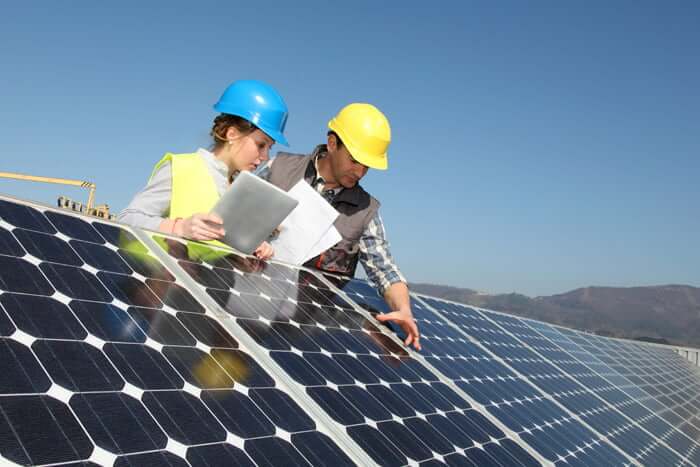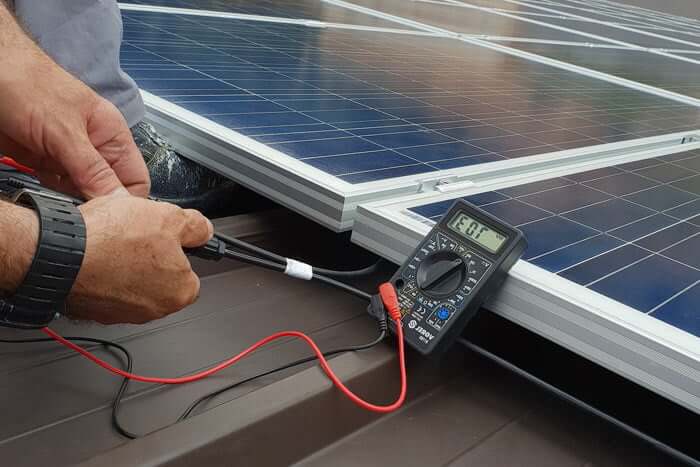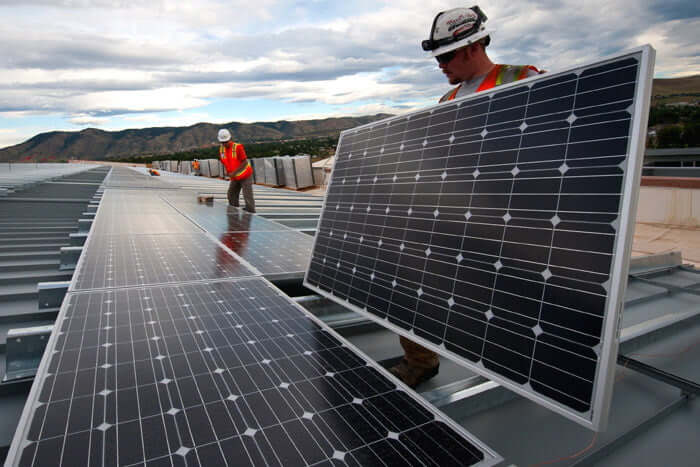Home Solar System Repairs Near Me
Solar System Repairs Near Me
One of the key motivations for numerous Australian families to opt for solar installations is the opportunity to drastically reduce their energy expenses. Installing a solar system might slash your power bills by up to 90%.
But when your solar system needs repairs, you may end up spending thousands if you don’t go about it the right way. The best thing you can do is to first consult several solar installers near you to get their opinion on what you should do.
Table of Contents
ToggleCan solar panels be repaired?
Yes! Most of the common solar panel faults can be repaired by solar experts, but it will depend on how they were installed. In most cases, the problem is usually with some solar cells and not the entire panels. This could be in the form of microcracks and hot spots.
However, when the panels are broken or cracked, there is no way to repair them. You can’t reattach any of the broken parts of a solar panel. The only option would be to replace the entire panel.
With that in mind, be wary of solar installers who assure you that they can repair such a panel.

Is it cheaper to repair or replace solar panel systems?
It depends. If your solar system has minor faults that can be easily fixed, then repairing the panel is a cheaper alternative. Repairing old solar panels that are no longer in production but are still in good condition is also a wise option. This might cost you anywhere from $80 to $500.
However, if your solar panels are broken or seriously damaged, repairing them will do no good. You’ll need to replace your solar system, which may cost you anywhere from $3,000 to $8,000, depending on where you live.
As a rule, ensure that you base your decision on the long-term financial impact. Know which alternative will save you more money after several years. For instance, if your solar system is too old and keeps breaking down, you’ll waste a ton on repairs – more than you would actually spend on a new system.
Do solar installers repair systems?
Yes! Most solar installers offer solar repair and maintenance as part of their services, especially for solar panels with poor documentation and warranty details.
But not every installer can handle the repair. Be sure to confirm with your installer if they offer repair services. You should also check the details of your warranty to ensure that you don’t violate it by using an installer for repair.
To be on the safe side with your warranty claim, go to your manufacturer for any repairs.

What does it cost to diagnose the issue?
There’s no fixed cost for how much an expert will charge you to diagnose the issue with your solar panels. It will all depend on the nature of the problem and the labor costs charged by your repair company, among numerous other factors.
Here’s an estimation of how much it would cost to diagnose the most common solar panel problems in Australia.
| Problem | Cost to Diagnose |
|---|---|
| Broken glass | $20 – $400 |
| Obstructing branches | $50 – $200 |
| Cracked Panels | $150 – $300 |
| Loose wiring | $100 |
| Corrosion | $150 – $350 |
| Damaged tiling | $2,000 – $3,000 |
| Broken Inverter | $1,000 – $2,000 |
Broken glass – Broken panel glass significantly reduces the power output of your solar panels and may allow water into the cells. The issue can be fixed for as low as $20 with the experts using a transparent laminating film or applying an epoxy. If the glass is severely broken, your only option may be replacing it for around $350 – $400.
Obstructing branches – If you notice your solar panels are victims of shading from stretched-out trees, you’ll have to spend some money on trimming and pruning the branches. This will cost you between $50 – $200.
Cracked panels – Cracked solar panels can be very costly when not addressed early – even though they can be fixed by simply soldering the panel edges. Most experts will charge you higher labor costs, at least $100 per hour, with the job taking an hour or two to complete. However, the panels may still require repair in extreme crack cases. You can expect to pay anywhere from $100 to $300 for this.
Loose wiring – In case of loose wiring, your solar repairer will have to cut through the silicon embedding the cell to reach the back of the cells so they can resolder the cells with poor connections. In some cases, they might also have to replace the silicon. This process mostly takes an hour to complete, with most experts charging $100 for it.
Corrosion – If the metallic parts of your solar panels have rust, your technician will have to replace them. This will cost you between $150 and $300.
Damaged Tiling – When part of your roof tiles is damaged, you may have to dismount your solar panels from the roof, then install them back. This process can be quite costly, and you’ll spend anywhere from $2,000 – $3,000.
Broken inverter – You don’t want an inverter that’s not converting as much AC current as you need. For small and simple inverter repairs, your expert may charge around $500. But since most inverters are better off replaced, you could spend between $1,000 and $2,000 for inverter replacement.
Keep in mind, these are but estimates which will vary from state to state. Other cost factors to consider includes:
- Size of your solar system – Large systems demand more time for inspection and repair. This results in higher costs.
- Type of panels – The type and brand of solar panels you use will dictate how much you pay in repair. Top-of-the-range panels generally cost more due to the higher cost of panel materials.
- Grade of the roof – The slope angle of your roof increases or decreases the repair time. Steep roofs will cost you more for repairs as the technicians will take longer to complete the process.

Weakest link in solar systems
In your solar system, several components work together to ensure efficient power generation and supply to your home or office.
However, depending on the system’s installation, any part of that system could be affecting its overall performance and hence, becomes the weak link. Here are the most common weak links:
Panels
Being the most crucial aspect of your solar system, the state of your solar panels has a massive impact on your solar system.
The biggest problem with solar panels is shading. Since most solar cells are connected in series connections, even the slightest shading on a cell could seriously dip the overall power output.
The shading could come from tree branches or accumulated dirt and bird waste on the panel surface. This is why it’s important to clean your solar panels regularly.
Cracks on the panel glass caused by the extreme weather conditions also expose the solar cells to damage from rainwater and snow.
Inverters
An inverter in your solar system is responsible for converting the generated DC current to AC. Having such a crucial role in your solar system, this is more often than not the problem if your solar system isn’t generating power.
Inverters have recently become one of the weakest links in solar systems mainly because of the numerous sub-standard brands in the market. With more Australian homeowners opting for these ‘cheap’ inverters over the more costly but high-quality inverters, they end up incurring more in repairs.
To ensure that this isn’t a problem for your system, go inverters that are independently verified and have a proven record of efficiency.
Wiring
Loose wiring on solar cells results in reduced power output from your solar systems. It results in up to 6% efficiency losses. This often happens if you purchase sub-standard solar panels or use inexperienced, shoddy installers for the job.
The solution for this problem is to have an expert inspect your solar system regularly and also get certified experts to do your installation.
Batteries
Affordable solar storage through batteries has for a long time been known as the weak link in renewable energy. The absence of affordable and effective solar batteries means most homes can’t afford to store energy and go off-grid.
The available, affordable solar batteries are also not up to standard, discharging quickly and lasting for a shorter lifespan than expected.
Grid connection
While the point of going solar is to avoid reliance on the national grid, the grid connections are a crucial component for homeowners to achieve a net-zero balance.
But in most cases, the tightening of grid connection requirements makes it nearly impossible to achieve this. The rising number of network faults, combined with the low budget allocated to network operators, makes it harder to expand the grid to accommodate renewable energy.
The only solution to this is for the government and utility companies to create a new and flexible transmission and distribution system that can accommodate the increasing power from inverter-based renewable energy sources like solar.
Do solar systems need regular servicing?
Yes! Like everything, solar systems need regular inspection and maintenance to remain in the best state. But since solar systems have no moving parts, the maintenance is very cheap and easy.
Most experts recommend that you maintain your panels at least twice a year, once every six months.
The good thing about this is that in most cases, the inspection and servicing are covered on your warranty. Depending on your agreement, this could go for up to 25 years and covers the labor costs. Just ensure that you don’t do anything that would void your warranty.
You’ll also find that in most cases, your panels will only need light surface cleaning and cutting tree branches to prevent shading.
Common cleaning tips for solar servicing
If you decide to clean your panels as a DIY instead of hiring an expert, here are a few tips:
First, ensure that your solar system is off before doing anything. Then, pick up your manufacturer manual and look for their recommended ways to clean the solar panels.
Next, take some time to look for cracks on the glass surface before applying any water. Using water on cracked surfaces may damage the solar cells. Consult an expert if you find any cracks.
Your next step should be removing leaves, bird debris, and dust from the glass surface and rinsing it off with warm water and detergent or a cleaning solution.
Your last step should be drying the panels, including the edges then monitor the power output of your panels. If their output remains low, consider involving an expert,
Tip: Choose a cool, cloudy day to do the cleaning. Cloudy days have lower evaporation rates and are not too hot for dirt and debris to quickly stick on the panel
How long do solar systems last?
The industrial average lifespan of solar systems in the market stands at 25 – 30 years. After this, they don’t stop generating power, but their efficiency significantly reduces. However, some panels still last more than 30 years, and others need replacement barely 20 years into use.
It all depends on the type of panels you have, your power consumption habits, and maintenance practices.
Does warranty cover system repairs?
Yes, but not all of them. Most solar manufacturers include repair costs for all components of the system in the workmanship warranty. Manufacturers offering this type of warranty are usually regarded as reliable and more trustworthy.
Only ensure that you don’t void your warranty by getting help from another manufacturer or installer or trying to repair the panels yourself.
Additionally, look out for manufacturers who offer you a workmanship warranty but disappear within the panels’ lifespan. This leaves you with no one to claim your warranty.
Opt for a manufacturer with a good history in the financial books. Manufacturers who have been in the market longer are usually a safe choice.
Does the installer or supplier cover warranty repairs and replacement?
Yes! Most installers and suppliers offer a 5 – 10 years warranty for their repairs and replacements. However, due to a large number of installers in the market, it’s easy to find installers who don’t offer a warranty – avoid them.
The biggest problem with solar installers’ warranties is their reliability. Most solar installers, even the big names, often go out of business within the lifetime of their warranty.
FAQs
There could be many reasons for this. One of them is the panel’s angle from the sun or the presence of shading, mostly from trees. Ensure your panels face North or the East-West direction and cut down any trees that might block the sun from reaching your panels.
If this isn’t the problem, consider having an expert look into your solar system. You might need to repair some components.
Compare Solar Panel Quotes
Table of Contents
Toggle









